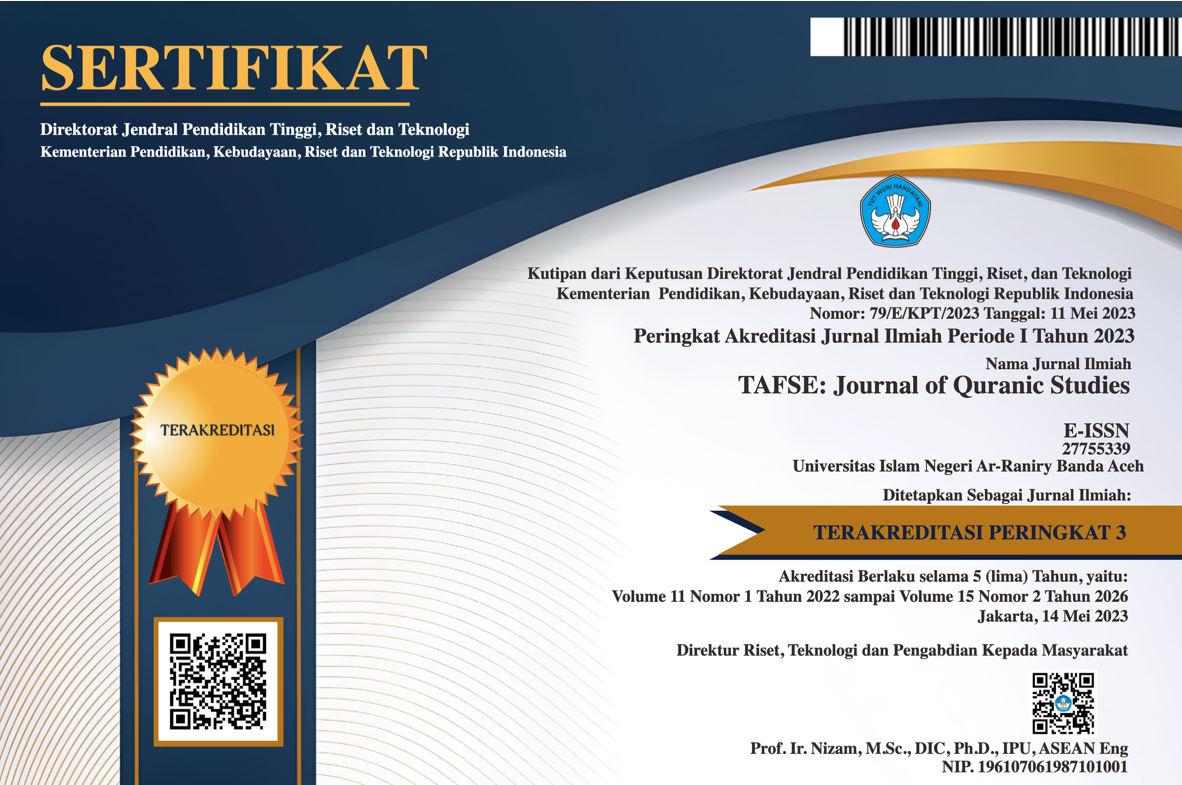Sistematika dan Persentase Bab-Bab Hadis
DOI:
https://doi.org/10.22373/tafse.v2i1.8076Keywords:
Sistematika, Kitab Sunan, Hadis, FikihAbstract
Sunan is a book compiled based on fiqh chapters or contains ahkam (law) traditions to be used as a reference for fiqh scholars in legal matters, such as the books of Sunan al-Nasai, Sunan Abi Dawud, Sunan al-Tirmidhi, Sunan Ibn Majah, and Sunan al-Darimi. However, there are differences in the systematics and percentages in some of these sunan books. To see this problem further, this literature review was carried out descriptively and comparatively by referring to related sources. In the book of sunan, it was found that there were some books that did not strictly use the systematics based on the fiqh chapter, as they were named the book of sunan. The systematics and percentage of hadith chapters in the Sunan book as a whole differ both in terms of the number of chapters and the number of hadith in the Sunan book.
Sunan adalah kitab yang disusun berdasarkan bab-bab fikih atau berisi tentang hadis-hadis ahkam (hukum) untuk dipakai sebagai referensi ulama fikih dalam istinbat hukum, seperti kitab Sunan al-Nasai, Sunan Abi Dawud, Sunan al-Tirmidzi, Sunan Ibnu Majah, dan Sunan al-Darimi. Namun, ada perbedaan dalam sistematika dan persentase pada beberapa kitab sunan tersebut. Untuk melihat permasalahan ini lebih lanjut, kajian kepustakaan ini dilakukan secara deskriptif dan komparatif dengan merujuk pada sumber-sumber terkait. Dalam kitab sunan, ditemukan ada sebagian kitab yang tidak secara ketat menggunakan sistematika berdasarkan bab fikih, sebagaimana penamaannya sebagai kitab sunan. Sistematika dan persentase bab-bab hadis dalam kitab sunan secara keseluruhannya berbeda-beda baik dari segi jumlah bab maupun jumlah hadis dalam kitab sunan tersebut.
Downloads
References
Abdul Rahman Ghazaly, Ghufron Ihsan, dan Sapiudin Shidiq. Fiqih Muamalah. Jakarta: Kencana, 2010.
Ali al-Khurasani al-Nasai, Sunan al-Nasai. Beirut: Dar al-Kitab al-‘Ilmiyah, t.th.
Arikunto, Suharsimi. Metodologi Penelitian. Yogyakarta: Bina Aksara, 2006.
Asy‘ath al-Sijistani. Abi Dawud Sulaiman. Sunan Abi Dawud. Beirut: Dar al-Fakr, t.th.
Dzulmani, Mengenal Kitab-kitab Hadis. Yogyakarta: Pustaka Insan Madani, 2008.
Abdul Rahman Ghazaly, dkk. Fiqih Muamalah. Jakarta: Kencana, 2010.
Ibnu, Nasrul. “Rangkuman Sejarah Perkembangan Ilmu Hadis”, diposting Agustus, 27,2015 http://www.ponpeshamka.com/2015/08/rangkuman-sejarah-perkembangan-ilmu.html
Ibrahim al-Darimi. Sunan al-Darimi. Dar al-Kitab Ilmiyah: Dar al-Ihya Sunnah Nabawiyah, t.th.
Totok Jumantoro. Kamus Ilmu Hadis. Jakarta: Bumi Aksara, 1997.
Abdul Majid Khan. Ulumul Hadis. Jakarta: Amzah, 2008.
Muhammad Hasbi ash-Shiddiqiey. Sejarah & Pengantar Ilmu Hadis. Semarang: PT. Pustaka Rizki Putra, 2009.
M. M. Azami, Memahami Ilmu Hadis Telaah Metodologi & Literatur Hadis. Jakarta: Lentera, 2003.
M. Syuhudi Ismail. Pengantar Ilmu Hadis. Bandung: Angkasa, 1991.
Mahmud Thahan. Intisari Ilmu Hadis. Malang: UIN Malang Press, 2007.
Abdul Wahid. Pengantar Ulumul Hadis. Banda Aceh: Pena, 2012.
Yazid al-Qurwaini Ibnu Majah. Sunan Ibnu Majah. Kairo: Dar al-Hadis, t.th.
Downloads
Published
Issue
Section
License
Authors who publish with this journal agree to the following terms:
- Authors retain copyright and grant the journal right of first publication with the work simultaneously licensed under a Creative Commons Attribution License (CC BY NC 4.0) that allows others to share the work with an acknowledgment of the work's authorship and initial publication in this journal.
- Authors are able to enter into separate, additional contractual arrangements for the non-exclusive distribution of the journal's published version of the work (e.g., post it to an institutional repository or publish it in a book), with an acknowledgment of its initial publication in this journal.
- Authors are permitted and encouraged to post their work online (e.g., in institutional repositories or on their website) prior to and during the submission process, as it can lead to productive exchanges, as well as earlier and greater citation of published work (See The Effect of Open Access).





